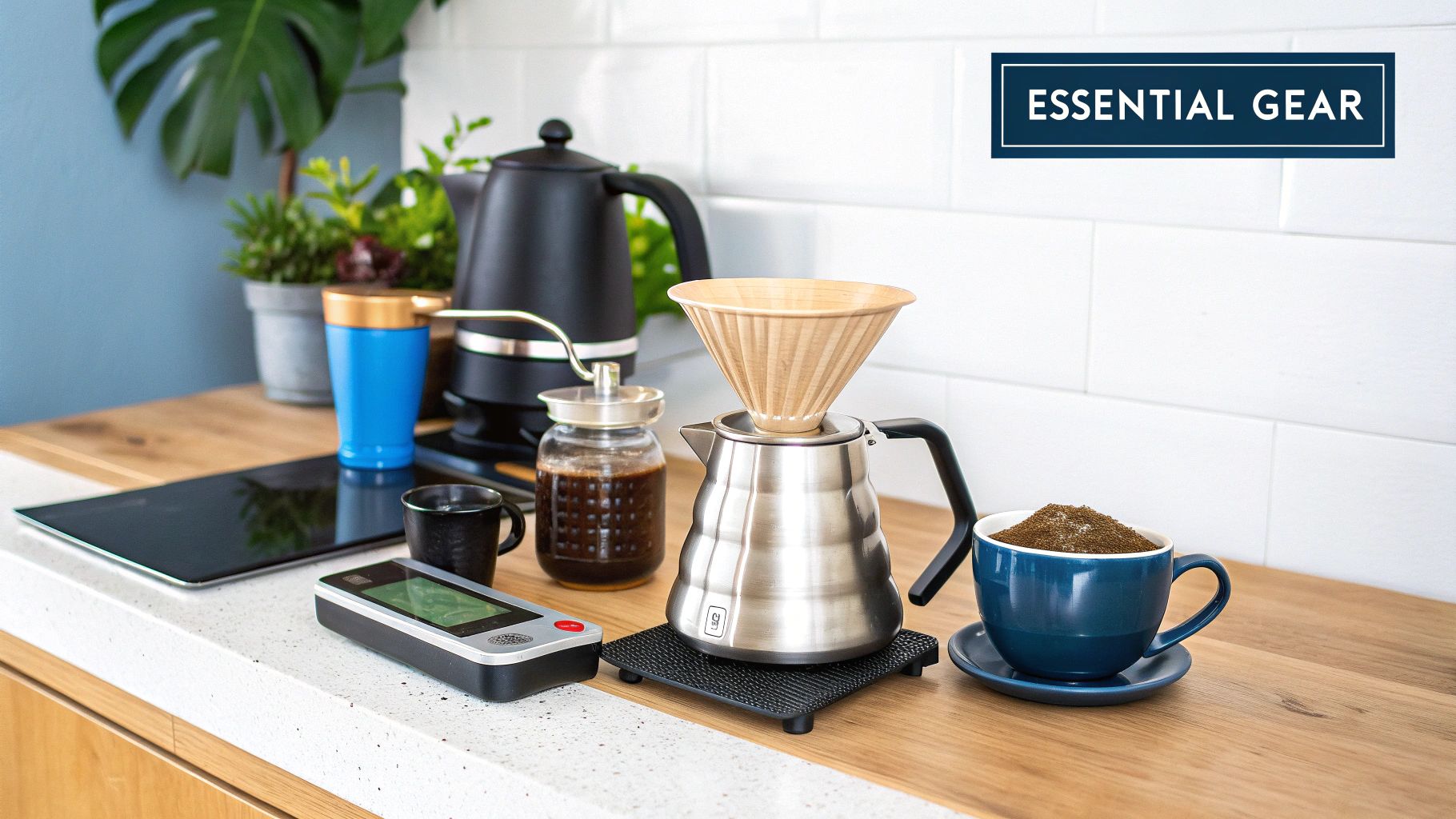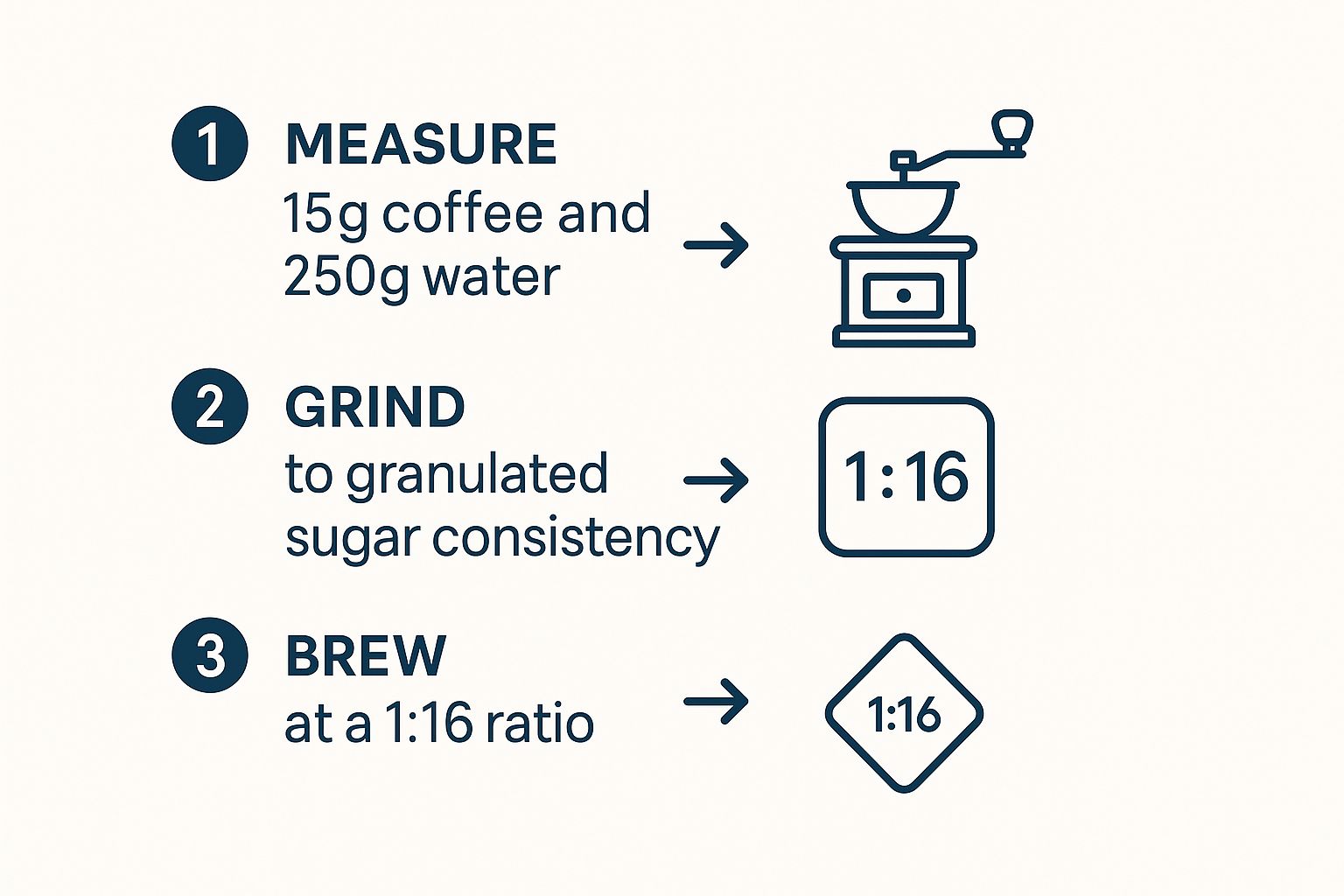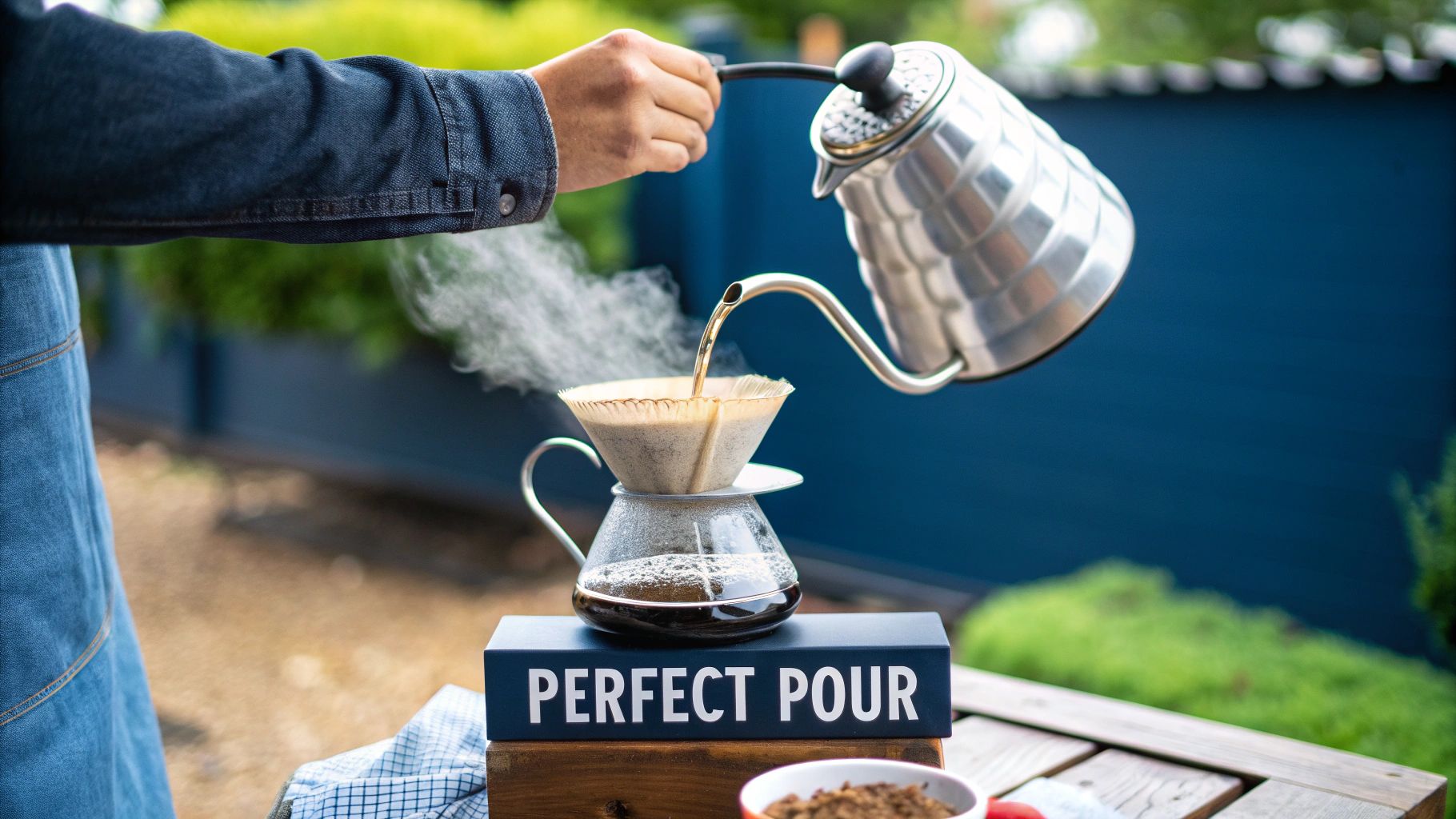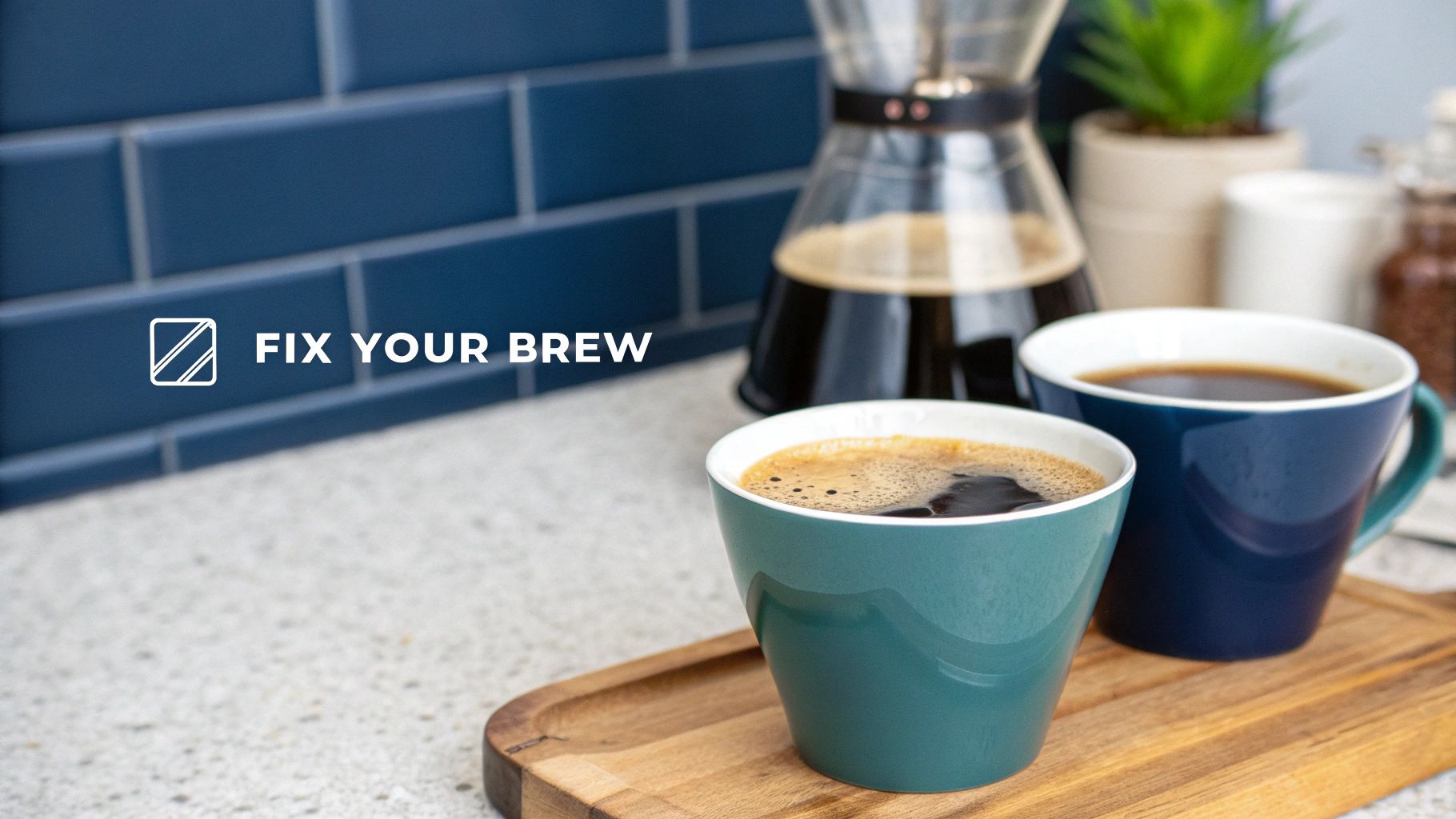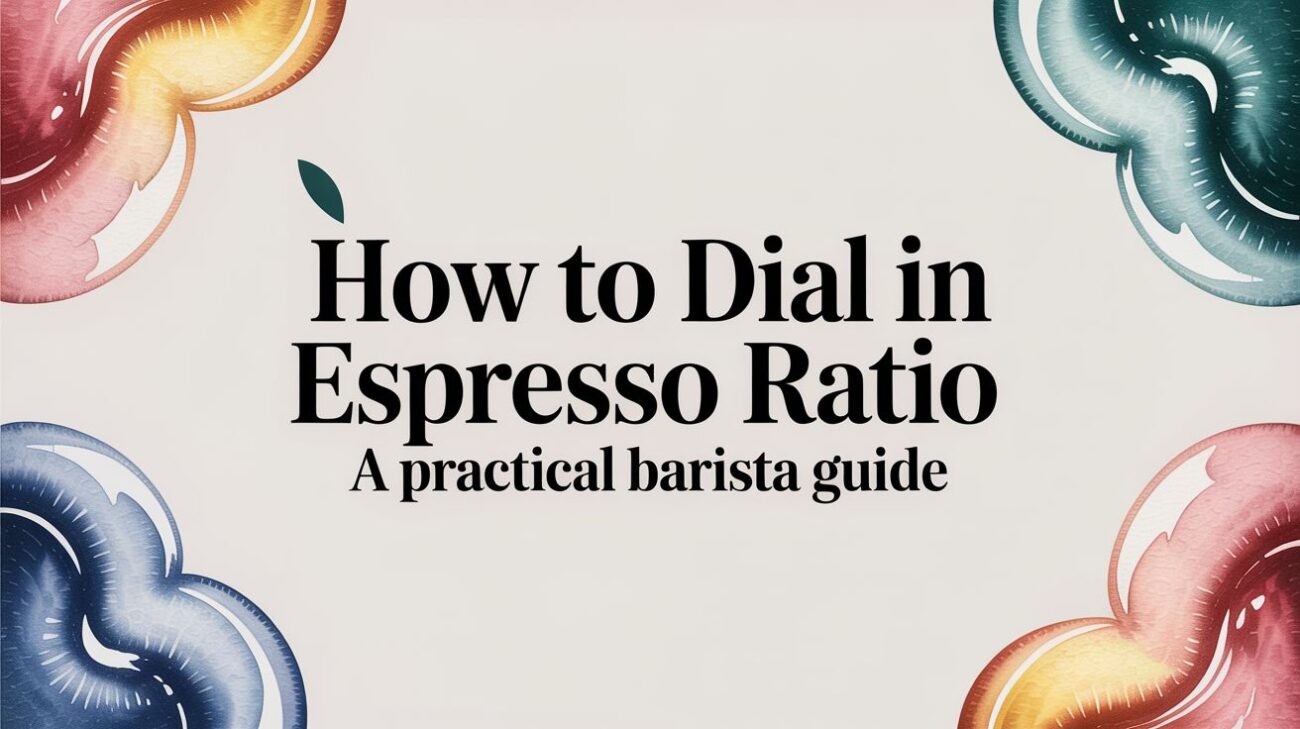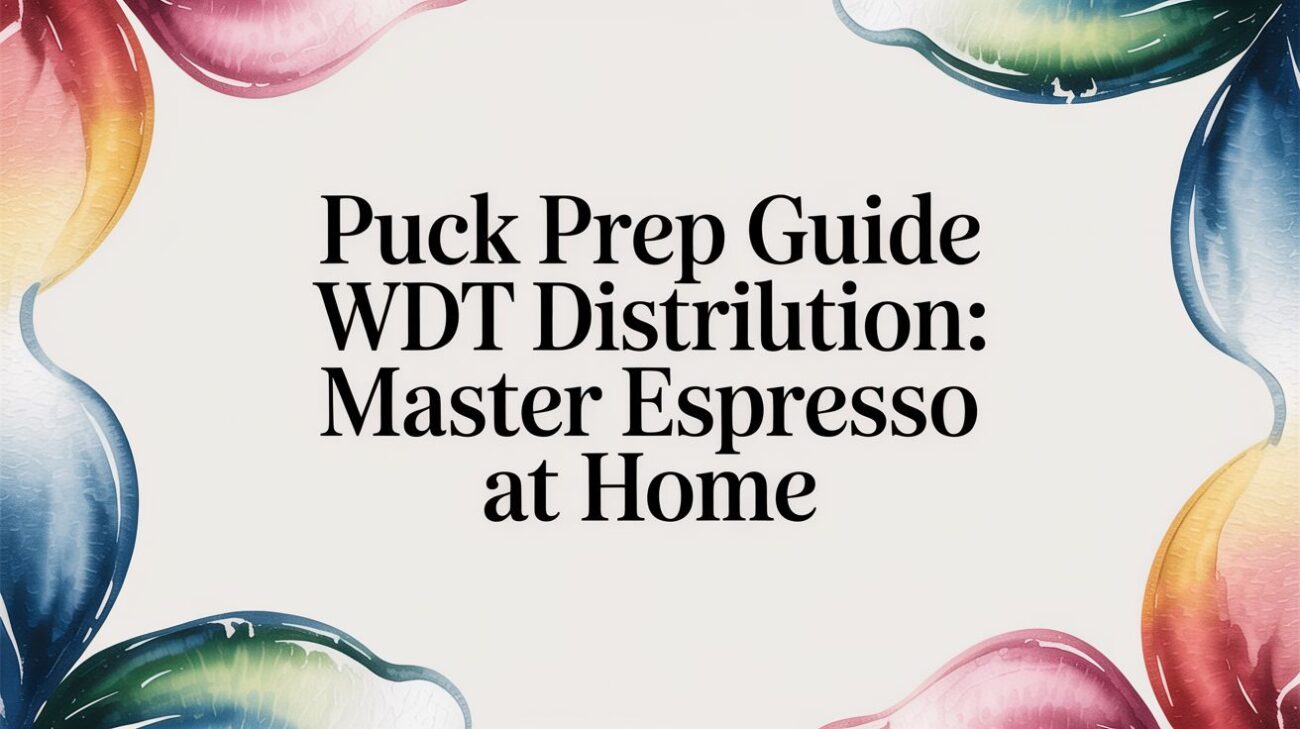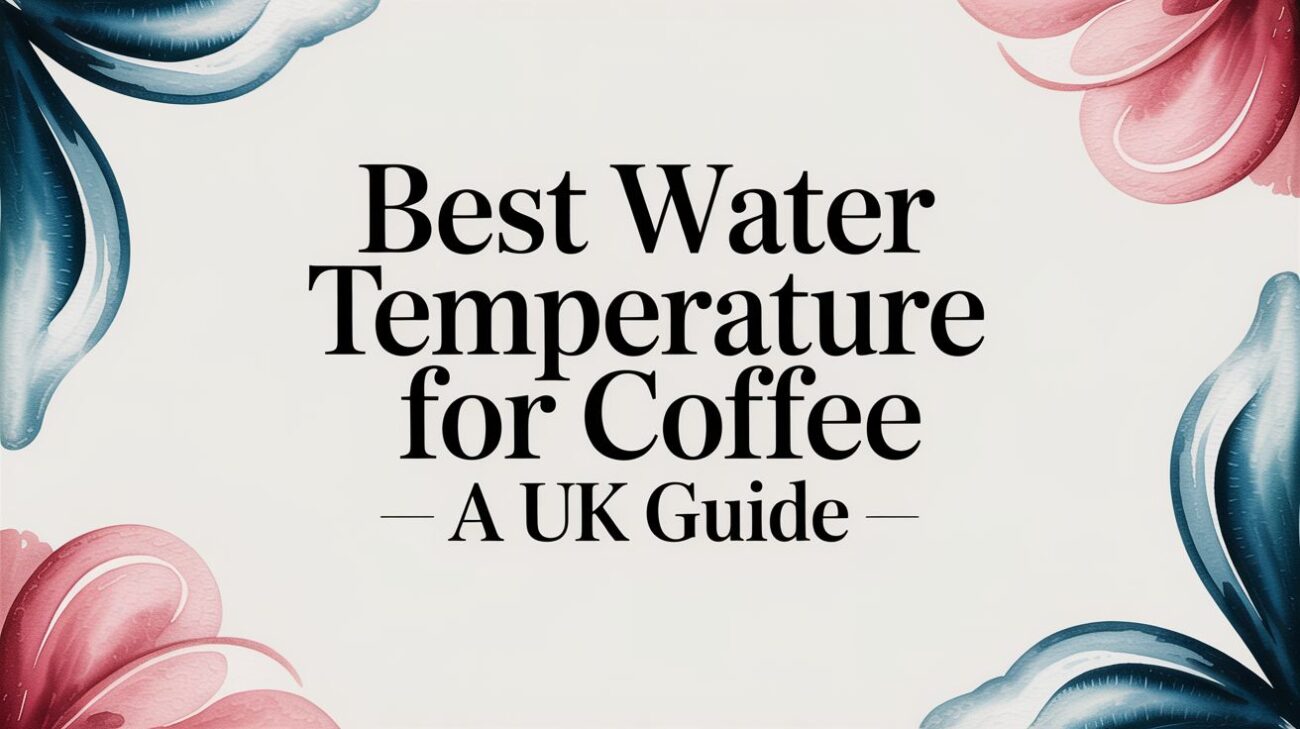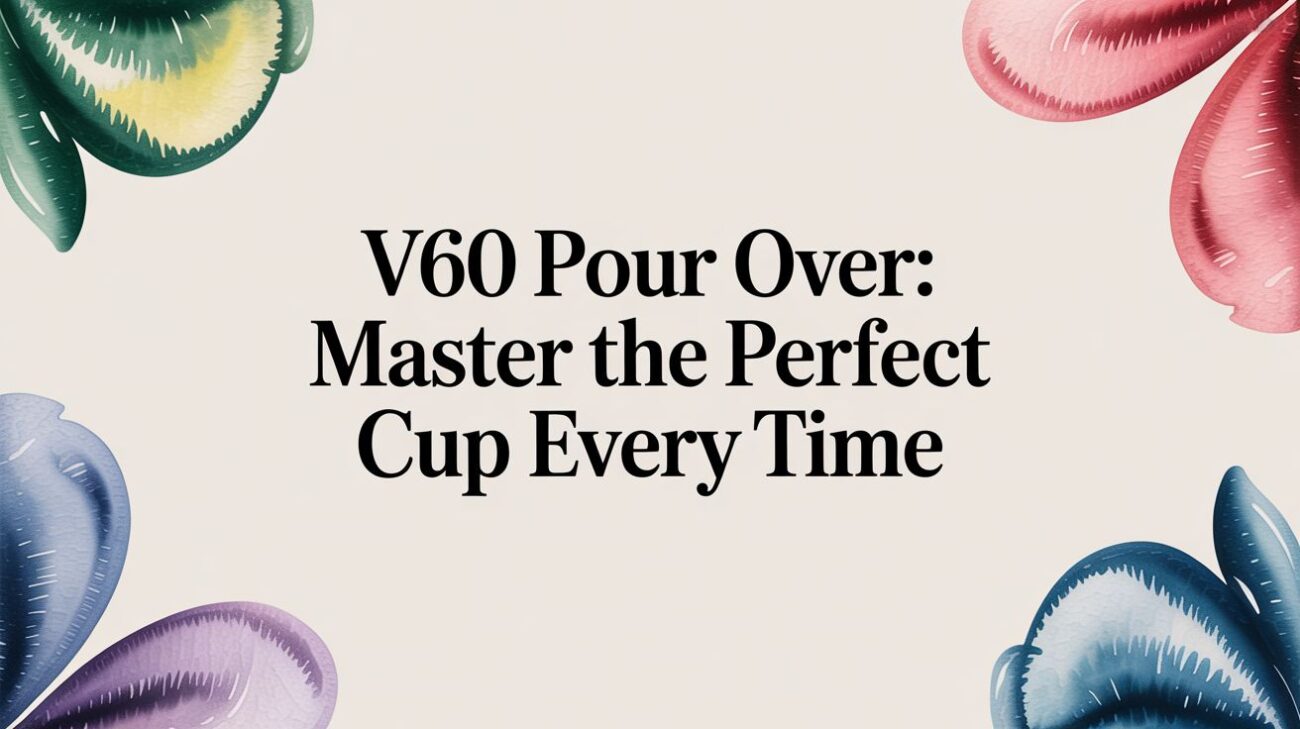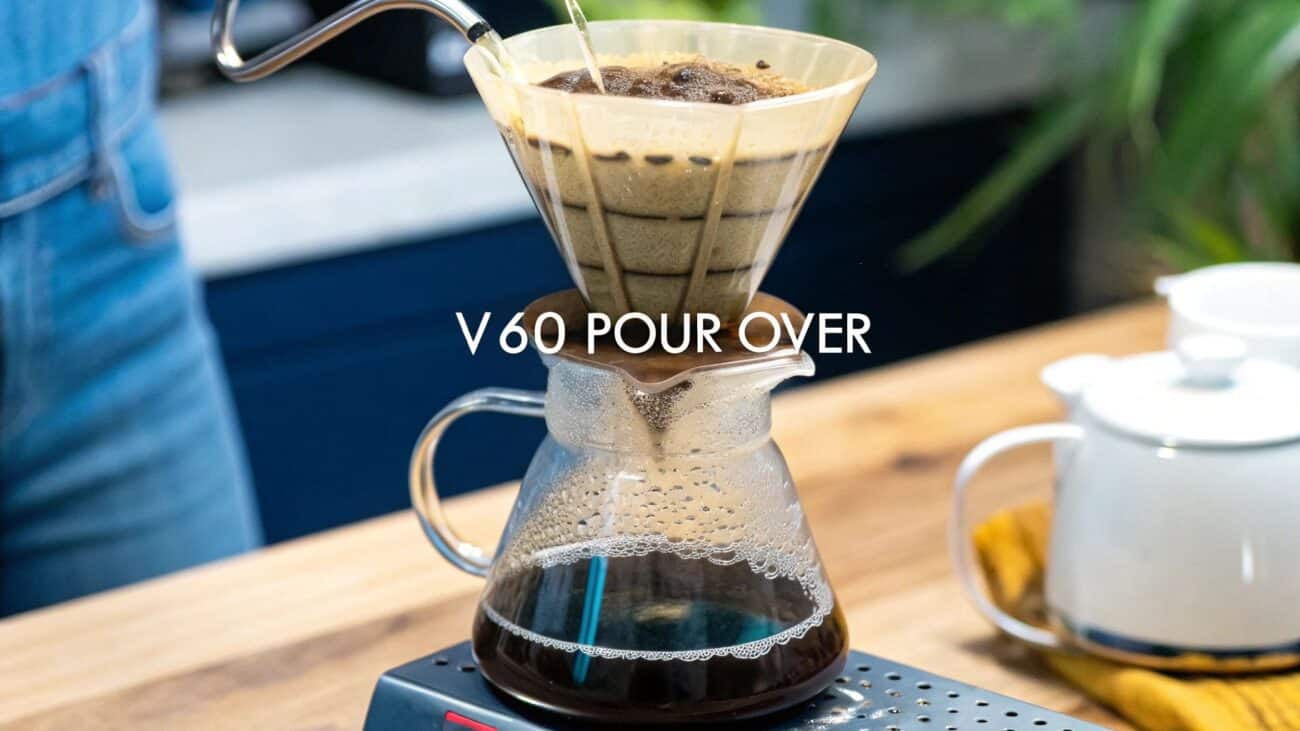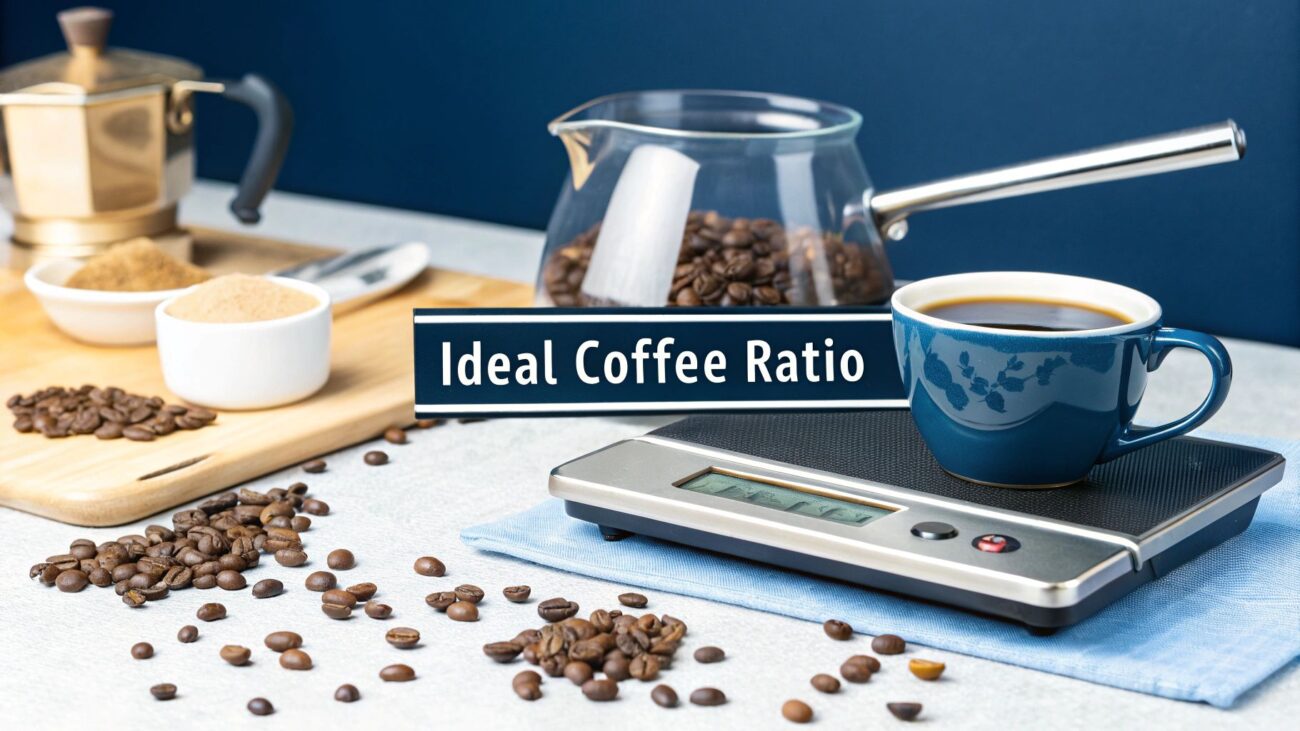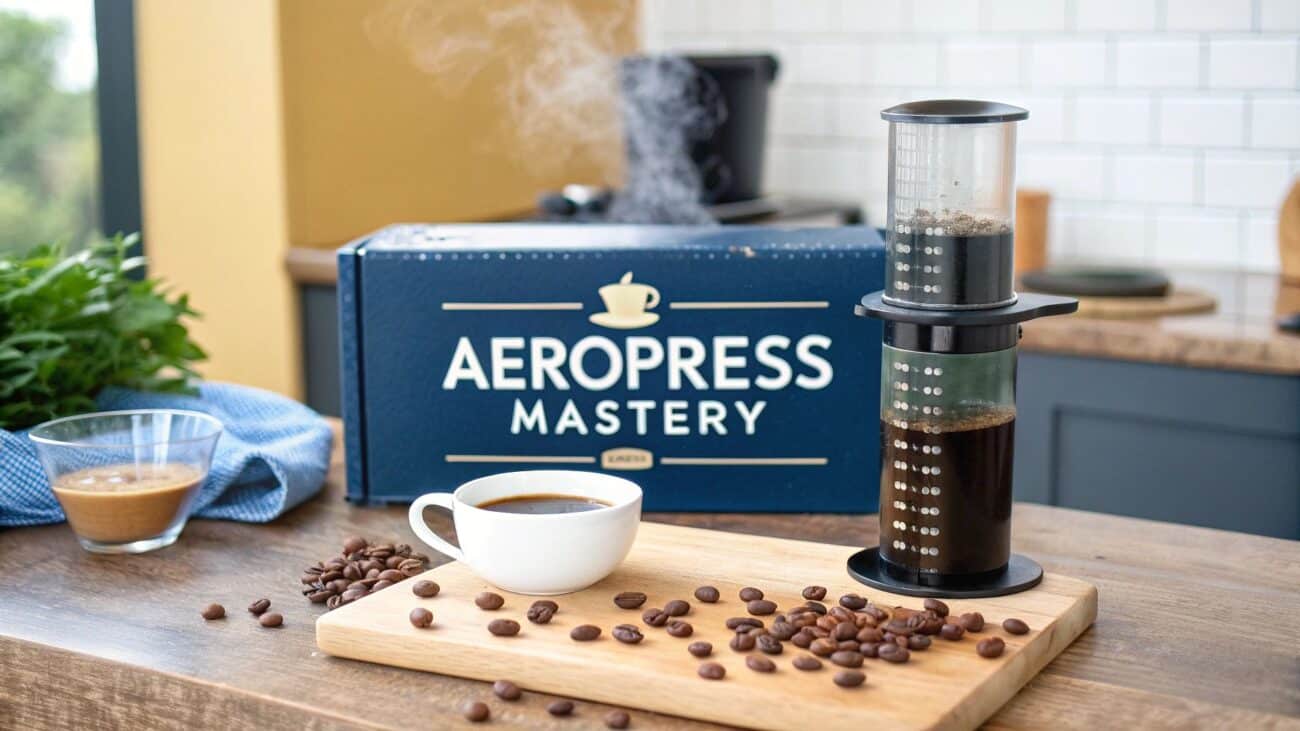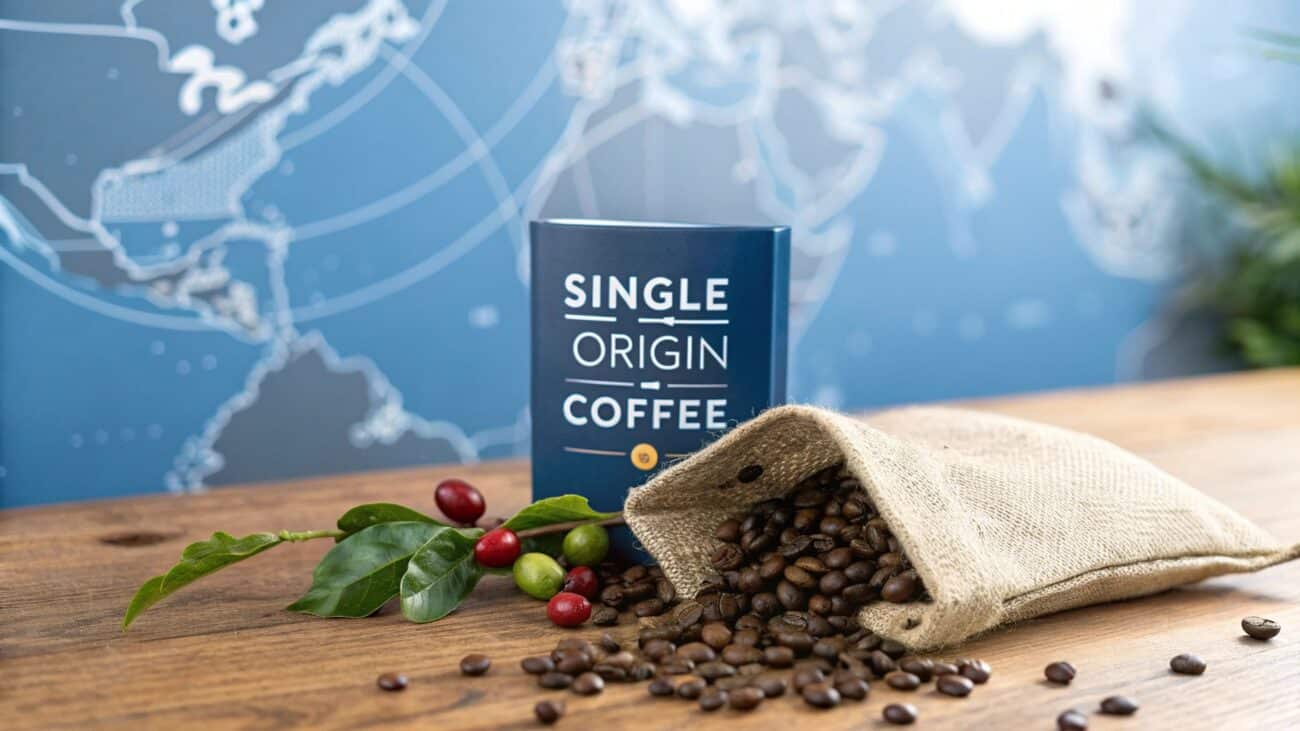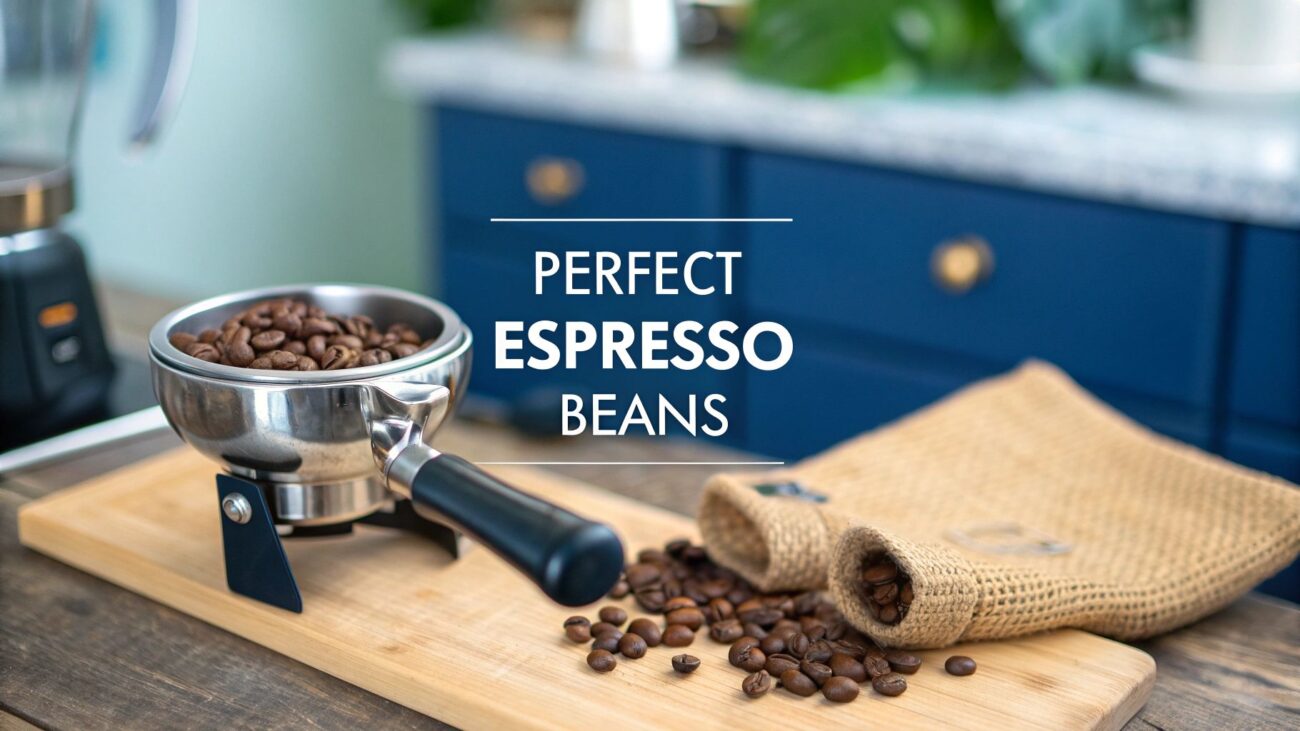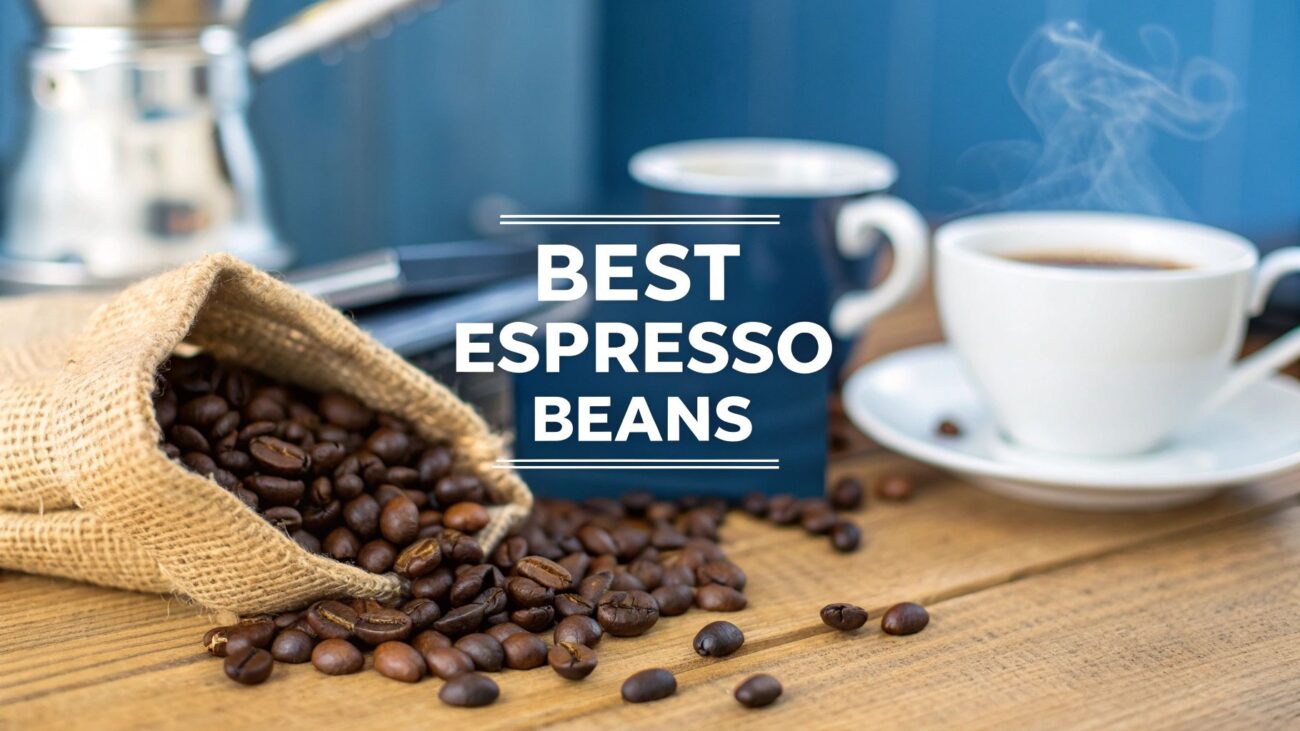Your Guide to Perfect Pour Over Coffee V60
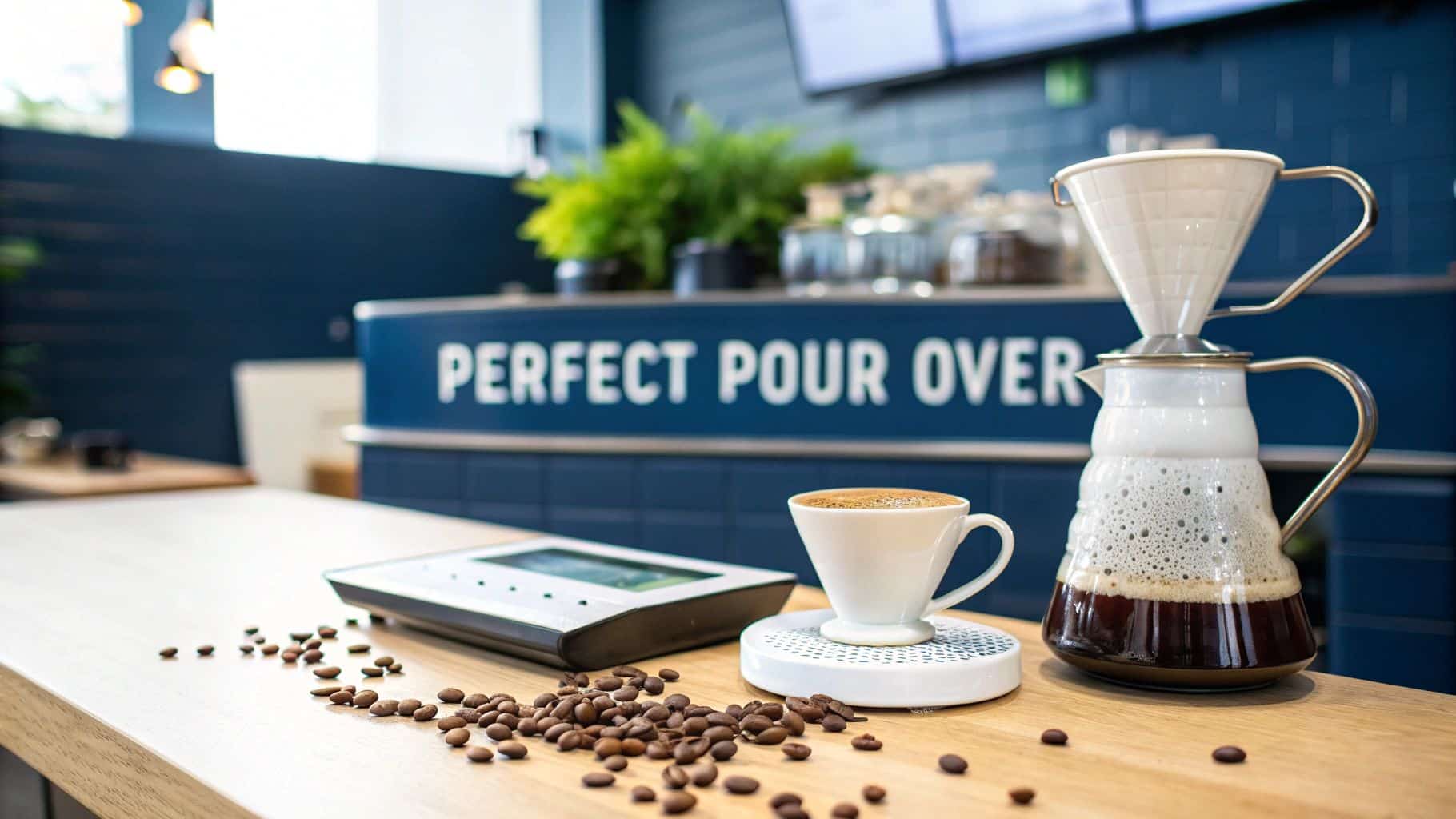
Brewing coffee with a V60 is a hands-on method that puts you in the driver's seat. It's about taking back control over your coffee's flavour, turning a daily routine into a mindful and rewarding ritual. The dripper itself is a clever bit of kit: a cone-shaped brewer with distinctive spiral ribs and a large single hole at the bottom. This design allows for a nuanced, clean cup that really lets the unique character of your coffee beans sing. It's little wonder this technique has become a firm favourite among UK coffee lovers for its precision and elegant simplicity.
Why the V60 Is a UK Coffee Favourite
In the UK, the Hario V60 has become more than just another brewing device; it's practically a symbol of the craft coffee movement. For many of us, the appeal is rooted in the deliberate, engaging process. Unlike hitting a button on an automated machine, the V60 demands your full attention, transforming a simple morning coffee into a moment of focus and craft. This manual approach is what builds a deeper connection to the drink in your cup.
This hands-on nature is precisely why it's so popular. You are in charge of every single variable:
- Water Temperature: You can fine-tune the heat to coax out different notes from your beans.
- Pouring Speed: A slow, steady pour can completely alter the body and sweetness of the final cup.
- Grind Size: Adjusting the coarseness of your grind directly impacts extraction time and flavour clarity.
The Rise of a Brewing Icon
The V60’s journey to fame is closely tied to the ‘third wave’ coffee scene, a movement that champions quality, origin, and brewing precision over sheer convenience. In that world, the V60 isn't just a tool—it's a way to explore the complex, delicate flavours of single-origin beans. Its knack for producing a bright, clean cup with distinct tasting notes resonates with home baristas and professionals who want to experience coffee at its absolute best.
The real beauty of the V60 is its elegant simplicity. It empowers you, the brewer, to directly influence the final taste, making each cup a unique creation. It’s less about a machine doing the work and more about the mindful actions you take.
This focus on manual brewing has become a hallmark of modern coffee culture across Britain. Pour-over coffee has been enthusiastically embraced by those seeking greater control over extraction. This mirrors a wider shift in the industry towards a more scientific approach to brewing, especially as 63% of UK adults now drink coffee regularly, finally overtaking tea. A growing number of them are now choosing speciality methods like the V60.
You can dive deeper into how different methods stack up in our guide to the best coffee brewing methods. For more on the industry trend, Perfect Daily Grind has some great insights on how pour over is changing coffee shops.
Gathering Your Essential V60 Brewing Gear
Before we can get into the satisfying ritual of brewing, you’ll need to get your kit sorted. While the world of coffee gear can feel a bit overwhelming, the great thing about a pour over coffee V60 is how simple the setup is. The goal isn’t to buy everything at once, but to start with the essentials that give you the most control.
Think of it less as a shopping list and more as building your foundation for reliably delicious coffee. Each piece of equipment plays a vital role in wrangling the variables that ultimately shape the flavour in your mug.
The Heart of Your Setup: The V60 Dripper
First things first, you need the V60 dripper. Hario makes these in a few different materials, and each one brings something slightly different to the table.
- Plastic: This is a brilliant and budget-friendly place to start. It’s tough, easy to travel with, and has surprisingly good heat retention. For anyone just getting into V60, a simple Hario V60 size 02 white plastic dripper is a fantastic choice.
- Ceramic: A classic for a reason. It looks great and holds heat exceptionally well, but you have to be diligent about preheating it properly to get a stable temperature throughout your brew.
- Metal: The most durable option out there. It offers fantastic heat retention and is built to last a lifetime, making it a great investment for the serious home brewer.
The main difference here is heat stability. Plastic is wonderfully forgiving and won't break the bank. Ceramic and metal, on the other hand, demand a bit more attention but reward you with rock-solid temperature consistency once you've preheated them.
Non-Negotiable Tools For Consistency
Now, while you could technically make pour over without the next few items, they are genuinely non-negotiable if you want to graduate from guesswork to greatness. These are the tools that separate a decent cup from a truly memorable one.
To get started with V60 pour over, it helps to understand which pieces of gear are absolutely essential and which are nice-to-haves. This table breaks down the core equipment, explaining why each item is important for achieving that perfect, repeatable brew.
Essential V60 Equipment Breakdown
| Equipment | Essential or Optional? | Why It Matters for Your Brew | Recommended Starting Point |
|---|---|---|---|
| V60 Dripper | Essential | This is the cone that holds the filter and coffee. Its design dictates water flow and extraction. | Hario V60 Plastic Dripper (Size 02) |
| Burr Grinder | Essential | Provides a consistent grind size for even extraction, preventing sour or bitter flavours. | A quality entry-level electric or manual burr grinder. |
| Digital Scales | Essential | Allows for precise measurement of coffee and water, crucial for nailing your brew ratio. | Any scale with 0.1g accuracy and a timer function. |
| Gooseneck Kettle | Essential | Offers precise control over the speed and placement of your pour, ensuring even saturation. | An electric or stovetop gooseneck kettle. |
| V60 Filter Papers | Essential | Specifically designed for the V60, these filters influence the flow rate and clarity of the coffee. | Hario V60 Paper Filters (bleached or unbleached). |
| Serving Carafe/Mug | Optional | A vessel to brew into. A dedicated server is nice, but any sturdy mug will do. | A heat-proof glass server or your favourite coffee mug. |
Having the right tools removes the guesswork, allowing you to focus on technique and perfecting your recipe.
First up is a quality burr grinder. Blade grinders smash beans into a chaotic mix of boulders and dust, leading to uneven extraction. A burr grinder, however, mills the beans to a uniform particle size. This is the secret to a balanced brew, avoiding the sourness from under-extracted chunks and the harsh bitterness from over-extracted fines. Honestly, it’s the single biggest upgrade you can make to your coffee game.
Next, you absolutely need digital scales. Brewing a V60 is a science of ratios—the precise relationship between the weight of your coffee and the weight of your water. Measuring in grams, not scoops, is the only way to guarantee you can repeat your successes and figure out what went wrong when a brew doesn't taste right. Look for scales that are accurate to 0.1 grams.
Finally, a gooseneck kettle is a must. That long, elegant spout isn’t just for looks; it gives you total command over your pour. You can control the speed, direction, and flow of the water with incredible precision, which is vital for evenly saturating the coffee grounds. You just can’t get that kind of control from a standard kitchen kettle.
A burr grinder and digital scales aren't just fancy extras; they are the bedrock of repeatable success. They take the ambiguity out of the process, empowering you to make small, deliberate tweaks to find your perfect brew.
Finding Your Perfect Grind and Ratio
Before a single drop of water even thinks about hitting your coffee, two crucial decisions will make or break your brew. Nailing the grind size and the coffee-to-water ratio is the real secret behind a consistently delicious pour over coffee V60. Get these sorted, and you're already most of the way to a perfectly balanced cup.
The sweet spot for a V60 grind is what I’d call a medium-fine setting, something that looks and feels a bit like granulated sugar or fine sea salt. This texture allows water to flow through the coffee bed at just the right pace. If you go too coarse, the water will just rush through, leaving you with a weak, sour, and frankly disappointing brew. But grind it too fine, almost like powder, and the water will get clogged up, over-extracting the grounds and creating a harsh, bitter cup.
Demystifying The Golden Ratio
Right alongside the grind, your brew ratio is your recipe for success. This is just a simple way of talking about the relationship between the weight of your coffee grounds and the weight of the water you pour over them. A brilliant place to start for any V60 brew is a 1:16 ratio.
This just means for every 1 gram of coffee, you'll be using 16 grams of water.
- For a standard single mug, a common recipe is 15g of coffee to 250g of water.
- Making a bigger batch for two? You could use 30g of coffee to 500g of water.
Don't treat this as a rigid rule, though. Feel free to play around with it. A 1:15 ratio will produce a slightly stronger, more intense brew, while pushing it to 1:17 will give you something a little lighter and more delicate. Just think of 1:16 as your reliable home base, a starting point you can tweak depending on your personal taste or the specific beans you're working with. If you're ever converting recipes, a good cups to grams converter can be a lifesaver for getting the maths right.
Getting the grind and ratio right isn't about rigid rules; it's about building an intuitive feel for how these two variables work together. A small adjustment to one will always impact the other, and learning to balance them is the core skill of a great home barista.
This infographic breaks down the starting process, showing how you go from measuring the beans to the final brew ratio.
It’s a great visual reminder of the core idea: precise measurements and a consistent grind are the foundation you build a great V60 on.
Part of the reason methods like the V60 are taking off in the UK is tied to a growing interest in where our products come from. More and more, coffee drinkers are curious about the story behind their beans. Since the V60 is a manual, electricity-free method that just needs a paper filter, it fits perfectly with a more mindful, eco-conscious approach to coffee. If you need some more detailed advice on getting your grind just right, you might want to check out our complete coffee grind size guide.
Mastering Your V60 Pouring Technique
This is where the real magic happens. With your gear ready and beans ground just right, the way you pour is your final conversation with the coffee. It’s how you gently coax out all those incredible flavours. Think of it less like following a rigid recipe and more like a fluid, sensory dance you get better at with every cup you brew.
Before any coffee even touches the dripper, there’s a crucial first step: rinsing the paper filter. This simple move does two important things. First, it washes away any of that papery taste that can sneak into your brew. Second, it preheats your V60 and server, keeping the temperature stable right from the get-go.
The Crucial First Pour: The Bloom
After you’ve tipped your grounds into the V60 and zeroed your scales, it’s time for the bloom. This is, without a doubt, the most important moment in the whole process. The bloom is that first splash of hot water, usually about double the weight of your coffee (40g of water for 20g of coffee), poured just to saturate the grounds completely.
You’ll see the coffee bed bubble and swell as carbon dioxide escapes—this is called de-gassing. Letting it bloom for around 30-45 seconds is non-negotiable for a few key reasons:
- Even Extraction: It gets the entire coffee bed ready for a consistent extraction by making sure every single particle is wet.
- Better Flavour: Releasing that CO2 stops it from creating little tunnels in the coffee bed, which would cause water to rush through and leave you with a sour, weak cup.
- The Aroma: This is your first real hint of the coffee’s incredible aroma, a beautiful preview of the flavours about to unfold.
Think of the bloom as waking up the coffee. This brief pause sets the stage for everything that follows, ensuring every particle of coffee contributes its full potential to the final cup. It's a non-negotiable step for a balanced brew.
Pulse Pouring Versus a Continuous Stream
Once the bloom is over, you need to add the rest of your water. There are two main approaches here: pulse pouring or one long, continuous pour. Neither is better than the other; they’re just different tools you can use to shape the final taste.
A continuous pour means adding all the remaining water in one slow, steady spiral, keeping the water level consistent. This approach tends to create a brighter, cleaner cup with a lighter body because it encourages a faster drawdown time.
On the other hand, pulse pouring involves adding water in stages. For example, you might pour 60g of water every 30 seconds until you hit your target brew weight. This technique creates more gentle agitation in the coffee bed and usually extends the contact time, often resulting in a brew with more body and a rounder, sweeter flavour.
The V60 method, first introduced by Hario back in 2005, really took off with UK coffee lovers because of the control it offers. Its precision fits perfectly with the high standards we’ve come to expect as our national coffee culture has matured. It's tricky to get exact figures, but its popularity reflects a bigger trend: the UK now sips around 98 million cups of coffee daily, with a huge shift from instant to quality ground coffee, especially among younger drinkers.
Experimenting with both pouring styles is a brilliant way to see how tiny adjustments can make a massive difference in the final cup. If you’re keen to explore more brewing techniques, you can find a lot of useful information in our other guides on how to brew coffee at home.
How to Troubleshoot Your V60 Brew
Even the most seasoned home baristas have off days. Don't worry about it—learning to read the signs and figure out what went wrong is a fundamental part of mastering the pour over coffee V60. Every single cup gives you feedback, telling you precisely what to tweak for next time.
Most brewing problems come down to two classic culprits: under-extraction or over-extraction. And thankfully, one small adjustment is usually all it takes to get things back on track.
Is Your Coffee Sour and Watery?
If your brew tastes sharp, grassy, or just disappointingly thin, you're dealing with under-extraction. This is what happens when water zips through the coffee grounds too quickly, failing to grab enough of the good stuff—the sweetness and complex flavours. The first place you should look is your grinder.
- The Problem: Your grind is almost certainly too coarse. Those large coffee particles create big gaps that let water rush through without enough contact time.
- The Fix: Go finer. Try adjusting your grinder by just one or two clicks. This simple change will slow down the water's flow, increase contact time, and pull out a much fuller flavour.
- Another Check: Make sure your water is hot enough. You want to be in the 90-96°C range. Water that’s too cool just doesn't have the energy to extract flavours properly.
Keep an eye on the clock, too. If your brew is all done in under two and a half minutes, that’s a tell-tale sign of under-extraction.
Adjusting one variable at a time is the golden rule of troubleshooting. Change your grind size first, brew again, and taste the difference before you even think about changing another element like your water temperature or ratio.
Is Your Coffee Bitter and Harsh?
On the other hand, if your coffee tastes unpleasantly bitter, dry, or sort of hollow, you've got a classic case of over-extraction. This happens when the water hangs around with the coffee for far too long, pulling out all sorts of harsh, unwanted compounds. The result is a brew that's probably taken ages to drain.
Here’s how to diagnose and fix it:
- The Problem: Your coffee grind is probably too fine. All those tiny particles are packing together and choking the flow of water, causing the brew to stall out.
- The Fix: Go coarser on your grind setting. It’s a straightforward fix that will create more space between the grounds, allowing the water to drain at a much healthier pace.
- Technique Check: How's your pour? Pouring too aggressively can kick up the fine particles and cause them to clog the filter paper. Aim for a gentle, controlled spiral instead.
A brew time that stretches past four minutes is often a one-way ticket to over-extraction. By dialling back your grind, you should see the total brew time drop back into that sweet spot of around three minutes, bringing balance and sweetness right back into your cup.
Common Questions About V60 Coffee
As you get deeper into the world of the V60, you'll naturally start to have questions. This is a good thing! It means you're paying attention to the details. We've gathered some of the most common queries we hear from home brewers to help you refine your technique and brew with more confidence.
Let's dive into the answers that will help take your coffee to the next level.
What Is the Best Water Temperature?
For a V60, the sweet spot for water temperature is generally between 90-96°C. This range is perfect for extracting all the delicious, soluble compounds from the coffee without scorching the grounds and introducing bitterness.
A simple trick is to boil your kettle and let it rest for about 30-45 seconds before you start pouring. This usually gets you right into that ideal zone.
If you're brewing a lighter roast, leaning towards the hotter end of the scale (96°C) can help unlock its complex, delicate notes. For darker roasts, dropping the temperature slightly can prevent any harsh, bitter flavours from dominating the cup.
The single biggest upgrade you can make for precision is a temperature-controlled kettle. It completely removes the guesswork and lets you replicate your ideal temperature every single time, giving you total control over one of brewing's most crucial variables.
Should I Use Pre-Ground Coffee?
While you can use pre-ground coffee, the difference in flavour when you grind fresh is night and day. The moment coffee is ground, it starts to lose its vibrant aromatic oils through a process called oxidation.
Freshly ground beans are the key to unlocking the full potential of your brew.
Investing in a quality burr grinder is hands-down the best move you can make for your home coffee setup. It gives you precise control over grind size—arguably the most important variable in brewing—and ensures you’re getting every last bit of flavour from your beans. To understand more about why freshness is so critical, our article on what is specialty coffee is a great read.
V60 vs Chemex What Is the Difference?
At a glance, they might look similar, but the V60 and the Chemex produce two very different styles of coffee. The main differences come down to the brewer's design and, crucially, the thickness of the filter paper.
-
Hario V60: The V60's steep cone angle, large single hole, and distinctive spiral ribs are all designed to encourage a faster flow rate. This puts more control in your hands and typically results in a bright, clean cup with a lighter body and more pronounced acidity.
-
Chemex: The Chemex uses a much thicker, proprietary paper filter that removes a significant amount of the coffee oils. This creates an exceptionally clean, almost tea-like brew with a silky-smooth finish, often highlighting subtle floral and fruit notes.
At Seven Sisters Coffee Co, we believe that great coffee starts with exceptional beans. Explore our curated selection of single-origin and blended coffees to elevate your V60 brewing experience. Discover your next favourite brew at https://sevensisterscoffee.co.uk.

